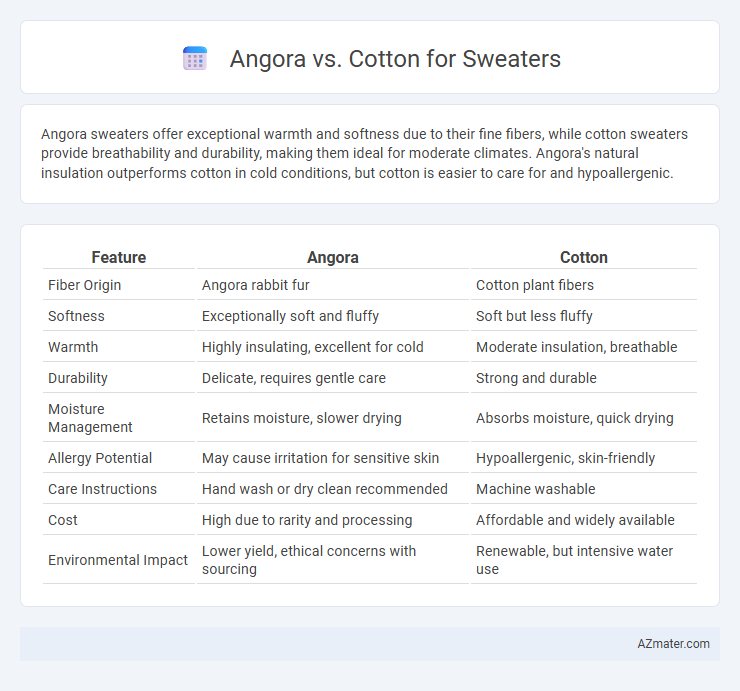Angora sweaters offer exceptional warmth and softness due to their fine fibers, while cotton sweaters provide breathability and durability, making them ideal for moderate climates. Angora's natural insulation outperforms cotton in cold conditions, but cotton is easier to care for and hypoallergenic.
Table of Comparison
| Feature | Angora | Cotton |
|---|---|---|
| Fiber Origin | Angora rabbit fur | Cotton plant fibers |
| Softness | Exceptionally soft and fluffy | Soft but less fluffy |
| Warmth | Highly insulating, excellent for cold | Moderate insulation, breathable |
| Durability | Delicate, requires gentle care | Strong and durable |
| Moisture Management | Retains moisture, slower drying | Absorbs moisture, quick drying |
| Allergy Potential | May cause irritation for sensitive skin | Hypoallergenic, skin-friendly |
| Care Instructions | Hand wash or dry clean recommended | Machine washable |
| Cost | High due to rarity and processing | Affordable and widely available |
| Environmental Impact | Lower yield, ethical concerns with sourcing | Renewable, but intensive water use |
Introduction: Angora vs Cotton Sweaters
Angora sweaters offer exceptional softness and warmth due to mohair fibers sourced from Angora rabbits, making them ideal for chilly climates. Cotton sweaters provide breathable comfort and durability, suitable for moderate temperatures and everyday wear. Choosing between Angora and cotton depends on desired insulation, texture, and seasonal use.
Fiber Origins and Production
Angora fibers originate from the Angora rabbit, prized for their exceptional softness and lightweight warmth, while cotton fibers come from the seed hairs of the cotton plant, known for breathability and durability. Angora production involves careful harvesting through combing or shearing the rabbit's silky coat, making it more labor-intensive and costly compared to cotton, which is mechanically harvested from cotton bolls on farms. These distinct fiber origins and production methods significantly impact the texture, insulation, and environmental footprint of sweaters made from each material.
Texture and Softness Comparison
Angora fibers provide an exceptional level of softness and a silky, luxurious texture that feels gentle against the skin, making it highly preferred for cozy sweaters. Cotton offers a smoother but firmer texture, with a breathable quality that ensures comfort while lessening the risk of itchiness compared to some animal fibers. The lightweight and fluffy nature of angora results in a sweater that is warmer and more insulating, whereas cotton sweaters are typically more durable and easier to maintain.
Warmth and Insulation Properties
Angora fibers, derived from Angora rabbits, provide superior warmth and insulation due to their hollow core structure that traps heat more efficiently than cotton. Cotton sweaters offer breathability and moisture-wicking properties but lack the same level of insulation, making them less effective in extreme cold conditions. Choosing Angora over cotton enhances thermal retention, resulting in a cozier garment ideal for winter wear.
Breathability and Comfort
Angora fibers provide exceptional softness and warmth, making them ideal for cozy sweaters, though their breathability is moderate due to the dense nature of the wool. Cotton offers superior breathability and moisture-wicking properties, ensuring comfort during warmer conditions or active wear. Combining angora with cotton can balance insulation with airflow, optimizing overall comfort in sweater fabrics.
Durability and Longevity
Angora fibers offer excellent insulation and softness but tend to be less durable than cotton, with a higher susceptibility to pilling and shedding, which can affect sweater longevity. Cotton sweaters provide strong durability and maintain structural integrity through repeated wear and washing, making them ideal for long-lasting garments. Choosing cotton ensures greater resistance to abrasion and fabric breakdown, while angora requires more delicate care to preserve its lifespan.
Allergies and Skin Sensitivity
Angora wool, derived from the Angora rabbit, is known for its softness but can cause allergic reactions or skin irritation due to lanolin and fine fibers that may penetrate sensitive skin. Cotton sweaters offer a hypoallergenic alternative, being breathable, moisture-wicking, and gentle on sensitive or allergy-prone skin. Choosing cotton reduces the risk of itchiness and redness, making it preferable for individuals with eczema or other dermatological conditions.
Care and Maintenance Requirements
Angora sweaters demand gentle care, requiring hand washing with cold water and mild detergent to preserve their softness and prevent fiber damage, while air drying flat avoids shrinking and matting. Cotton sweaters are more durable, often machine washable on a gentle cycle, but should be dried flat or tumble dried on low to maintain shape and prevent stretching. Proper storage in a cool, dry place with moth repellents is essential for both materials to extend garment longevity and retain quality.
Environmental Impact and Sustainability
Angora wool, derived from Angora rabbits, is a renewable and biodegradable fiber but raises ethical concerns due to animal welfare and the intensive farming practices required, which can impact local ecosystems. Cotton, while also natural and biodegradable, often involves high water consumption, pesticide use, and soil degradation, leading to significant environmental footprints without sustainable practices like organic farming. Opting for ethically sourced Angora or certified organic cotton can reduce environmental impacts and support more sustainable sweater production.
Which Sweater Is Better: Angora or Cotton?
Angora sweaters offer superior warmth and softness due to the fine, fluffy fibers harvested from Angora rabbits, making them ideal for cold weather and luxury garments. Cotton sweaters provide breathability, durability, and easy care, perfect for moderate climates and everyday wear. Choosing between Angora and cotton depends on prioritizing insulation and softness versus practicality and moisture-wicking properties.

Infographic: Angora vs Cotton for Sweater
 azmater.com
azmater.com